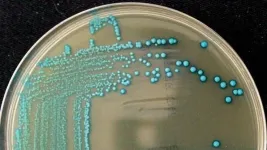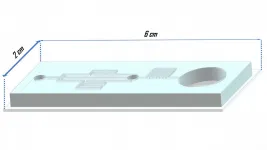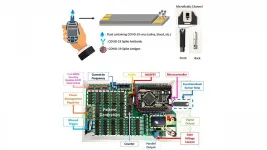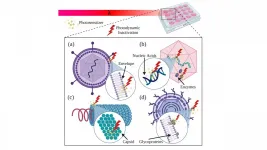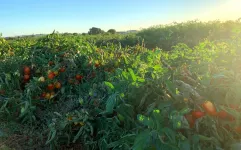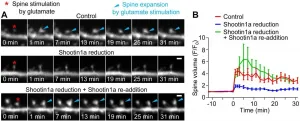For the first time, researchers can quantitatively predict blood flow conditions that likely cause pathological behavior of the human blood protein von Willebrand factor (vWF). Predictions from this new method of simulation, developed at Lehigh University, can be used to optimize the design of the mechanical pumps known as left ventricular assist devices used in heart failure patients. The method also has the potential to improve diagnosis and treatment of von Willebrand disease, the most common inherited bleeding disorder in the U.S., according to the Centers for Disease Control and Prevention.
The article, "Predicting pathological von Willebrand factor unraveling in elongational flow," appears today in the May 18 issue of Biophysical Journal. In it, the team of researchers used an enhanced sampling technique called Weighted Ensemble, in conjunction with Brownian Dynamics simulations (i.e., the WEBD method), to identify blood flow conditions that cause pathological unraveling of the human blood protein vWF. The method allowed them to compute the globular-to-unraveled transition rate of the protein on timescales inaccessible to standard simulation methods.
"This method is all about studying the kinetics of rare events," says co-author Edmund Webb III, an associate professor of mechanical engineering and mechanics in Lehigh's P.C. Rossin College of Engineering and Applied Science. "That typically means some type of transition. With proteins, that often comes down to folding."
The protein known as vWF promotes blood clotting by helping platelets in blood stick to collagen within the walls of damaged blood vessels and form a plug that stops the bleeding from a wound.
Typically, vWF circulates in the blood as a compact ball, or globule. When it approaches an injury site, the increase in blood flow caused by the laceration prompts the globule to unravel. As the protein transitions into more of a string-like shape, sites that are typically shielded when vWf is in a globule shape become exposed. Those sites are "sticky"--and they bind with platelets and collagen to initiate blood clot formation.
There are a number of ways in which the clotting process can go awry, leading to bleeding disorders. One of these is called von Willebrand disease (vWD), and it affects about 1 percent of Americans (or 1 in every 100 people), according to the CDC. Its primary symptoms include frequent nosebleeds, easy bruising, and heavy and/or longer bleeding after injury, childbirth, surgery, or dental work, or during menstrual periods.
There are several types of vWD, and they range in severity based on the degree to which vWF is depleted in a patient's blood. Some people don't even know they have the condition, because the vWF concentration in their blood, though depleted, is still sufficiently high to initiate clotting. Some have to steer clear of certain activities to avoid injury. Others need regular infusions of vWF, because they are severely lacking in the protein.
The lead study author is Sagar Kania, a Rossin College PhD student in mechanical engineering and mechanics. Kania and Webb performed the work with their Lehigh coauthors, Alp Oztekin, a professor of mechanical engineering and mechanics, Xuanhong Cheng, a professor of bioengineering and materials science and engineering, and X. Frank Zhang, an associate professor of bioengineering.
The team focused on first understanding blood flow conditions in which otherwise healthy vWF would exhibit undesired unraveling. This is a question whose answer has a direct impact on the design of left ventricular assist devices (LVADs), which have been associated with causing unexpected vWF depletion and associated bleeding disorders, akin to vWD. The symptoms are essentially the same so, medically speaking, in addition to being hereditary, von Willebrand disease can be acquired either by the action of a medical device or as a result of a separate medical condition.
Undesired unraveling of vWF is considered a necessary first step to pathological vWF depletion and associated bleeding disorders. In normal conditions, vWF is made within the walls of blood vessels and then secreted into the blood.
"And when it gets secreted, it's way too big," Webb says.
So that secretion simultaneously activates an enzyme (called ADAMTS13) that cuts the very long proteins into shorter lengths that are appropriately sized for their blood-clotting duties. Those shorter proteins contract to a globule shape, and then flow through the blood until they encounter an injury site, at which point they unravel, stick to platelets and collagen, and initiate the process of plugging the hole in damaged blood vessels.
The specific problem that the team studied for this paper arises when vWF unravels when it shouldn't. In other words, not in response to a wound. When that happens, the cutting enzyme may again be activated.
"So upon secretion into blood, von Willebrand factor proteins are circulating in normal blood flow conditions, and yet they're unraveling because they are very long," says Webb. "Since they are unraveling, they're getting cut down to the normal size distribution. But in pathological conditions they continue to unravel, and they get cut to the point where they are too small to be functional. They become short segments that are no longer hemostatically active; so if you get a cut, you can't clot because you don't have enough properly sized von Willebrand factor circulating around."
So what are the blood flow conditions that cause vWF to unravel when it shouldn't? To answer that question, Kania and coauthors combined the enhanced sampling technique (Weighted Ensemble) with molecular scale (Brownian Dynamics) simulations. This required executing parallel simulations--computations that are performed across many computers at the same time--supported by Lehigh's Sol and Hawk computational clusters, as well as resources from the Xtreme Science and Engineering Discovery Environment (XSEDE), a national supercomputing resource made possible by the National Science Foundation.
"The big problem," says Webb, "is that bleeding disorders can be associated with the clearance of von Willebrand factor on timescales that might be on the order of minutes to hours. Molecular-scale simulations have to go through time sequentially, using a really, really tiny time step. For us to get a one-second simulation is effectively a state-of-the-art calculation."
Webb further points out that developing a robust understanding of the statistical nature of rare unraveling events requires many such simulations, making such an approach intractable.
"What this paper did was use a new method of simulation combined with our preexisting method of simulation to answer questions on longer timescales. It's generally referred to as timescale bridging, because we're taking a model designed to address questions on the order of micro- to milliseconds and combining it with a new theoretical technique that allows us to answer questions about things that would happen on timescales of seconds, minutes, hours, even days."
It's truly a novel approach to predicting this type of an event, he says.
"This Weighted Ensemble method and the marriage of it to this type of problem has never been done before," Webb explains. "Sagar has made some predictions about pathological flow conditions that appear to be quantitatively more accurate than what previously exists in the literature. So we can now say, 'If a certain blood flow exposure occurs, you're going to have issues.'"
The breakthrough is potentially very good news for patients with heart failure. It may help manufacturers of LVADs design the blood pumps so the flow they generate doesn't create pathological conditions for vWF.
Beyond benefiting those in need of medical implants, the team's method may eventually help medical professionals better understand and potentially manipulate the complex flow conditions affecting the size distribution of vWF in their patients. This could lead to improved treatment of both acquired and hereditary vWD.
The ultimate goal, Webb says, is to take this type of capability and knowledge beyond just vWF to develop targeted drug therapy using flow-responsive molecules that mimic the unraveling of vWF. So if a patient is at risk for heart attack or stroke because of plaque buildup (stenosis), the molecule could deliver a drug to that precise area.
"You design a molecule that unravels in specific flow fields associated with certain degrees of stenosis," says Webb. "The hope is that you would get the drug to the spot where you want it, and not anywhere else in the body. We're working on this right now."
INFORMATION:
Related Links:
Biophysical Journal (Vol 120, Issue 10, P1903-1915, May 18, 2021:"Predicting pathological von Willebrand factor unraveling in elongational flow"
Rossin College Faculty Profile: Edward Webb III
Rossin College Faculty Profile: Alparslan Oztekin
Rossin College Faculty Profile: Xuanhong Cheng
Rossin College Faculty Profile: X. Frank Zhang

